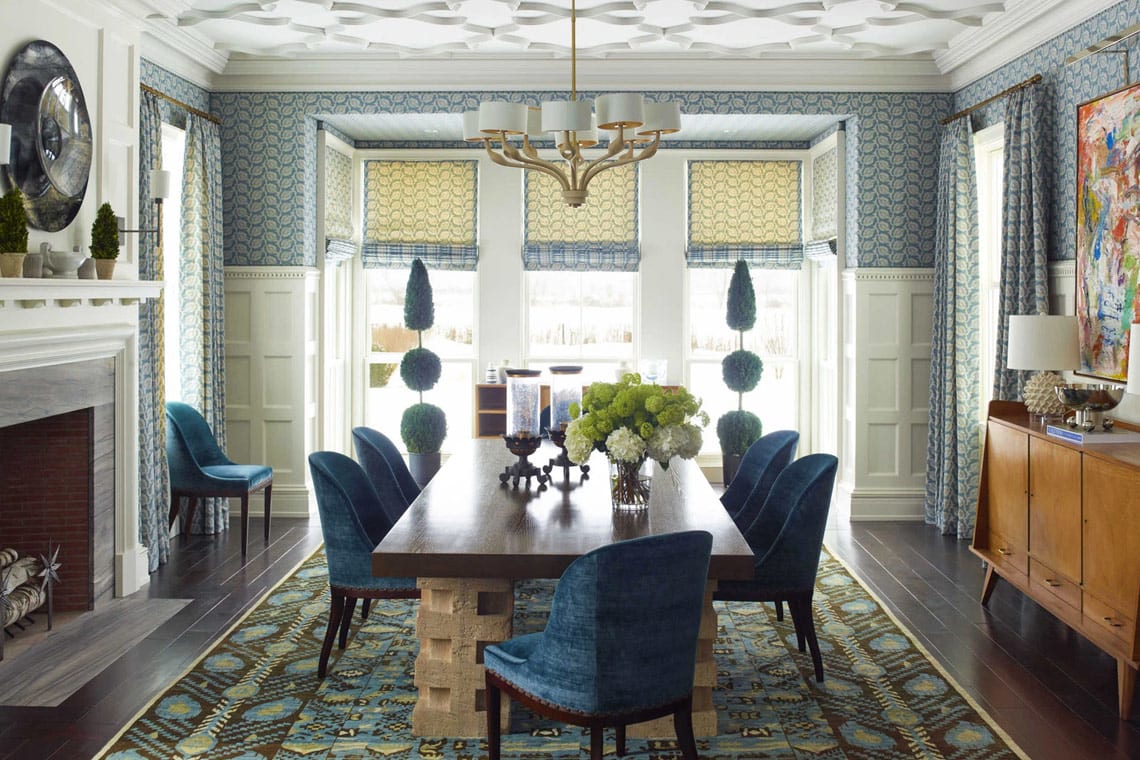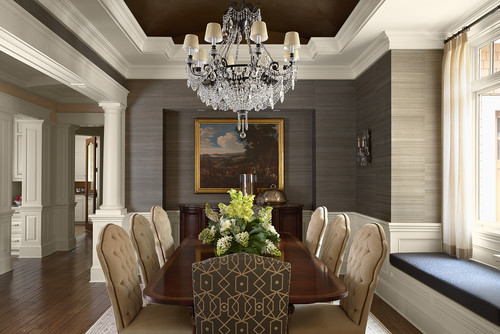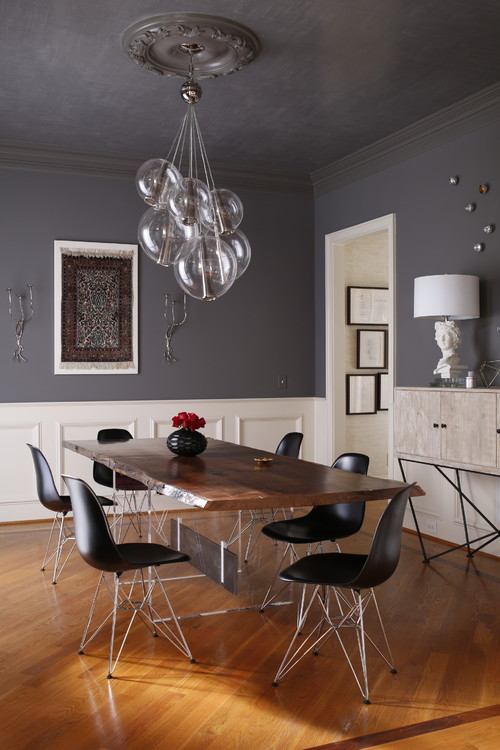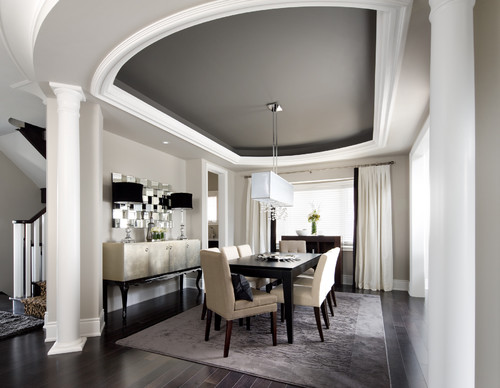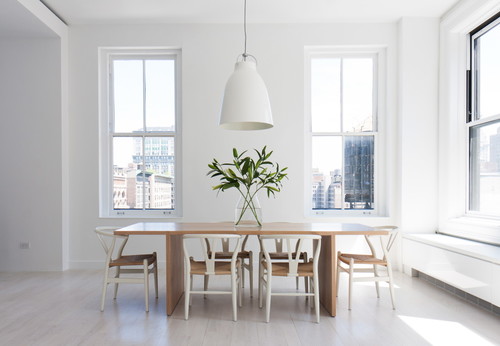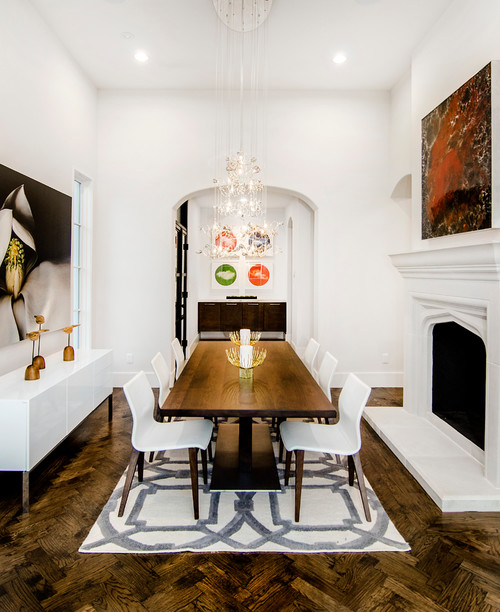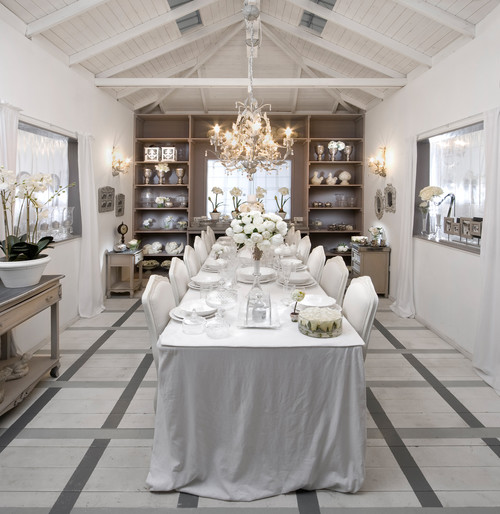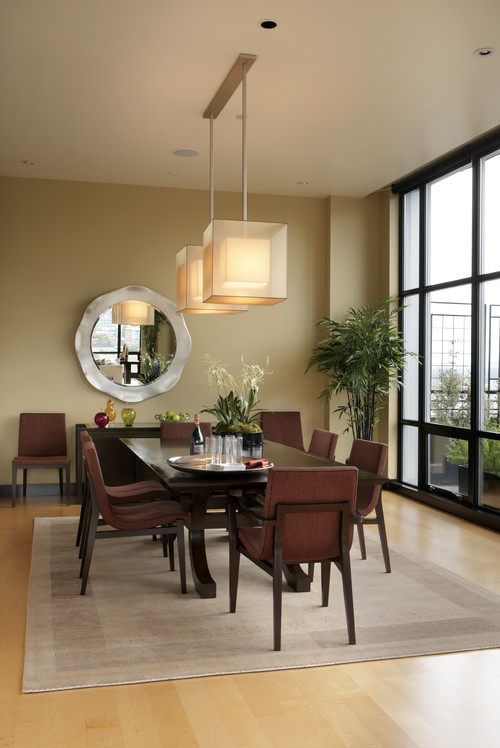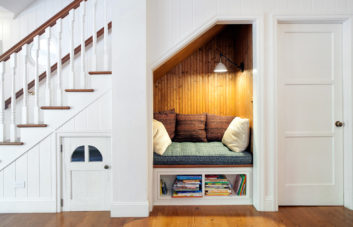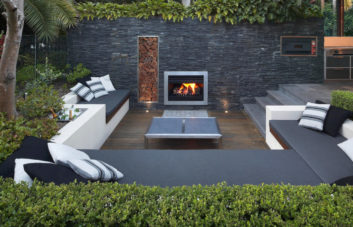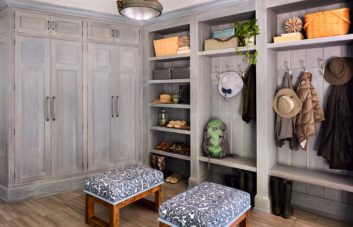The formal dining room: it’s (unfortunately) losing popularity in new homes, but there’s nothing like a separate, elegant room for special occasions and fancy dinners to give your home a new level of sophistication. It’s a place to connect intimately over food, fine wine, friends and family.
Because formal dining rooms are increasingly replaced by multi-purpose dining rooms (that double as offices, music rooms, living rooms…) or phased out entirely in favor of an open-plan dining area off the kitchen (formerly known as a “dinette” or eat-in kitchen), it can be hard to find inspiration for yours. Many decor sites and blogs have plenty of pieces on how to use your dining room creatively and rethinking or repurposing the dining room, but not much on how to decorate a dining room as… a dining room.
For the sake of traditional dining room lovers everywhere, we present the most important elements to consider in planning a tasteful formal dining room. The main categories to address are:
Walls
The formal dining room is often characterized by rich, sophisticated colors and patterns. Due to the fact that we realistically do not spend much time in it, the dining room is the perfect place for experimenting with bolder colors. Deep colors like navy, charcoal, and burgundy are classics; wallpaper in similar shades is popular once again, especially textured papers like grasscloth or those with a metallic sheen for visual interest.
In a formal dining room, wood is the obvious – but not always the best or most practical – choice. It’s classic, versatile, and beautiful; it can be refinished as necessary; it’s available in a massive array of sizes, shapes, installation patterns, and colors. Be aware, however, that wood does need extra care – special cleaning agents, regular maintenance – and the cost is obviously a factor as well.
That’s where professional cleaning services come into play. Maintaining a wood dining room floor can be time-consuming and requires the right techniques to preserve its natural beauty. Instead of spending hours scrubbing and polishing, many homeowners turn to expert cleaners who understand the nuances of wood care. From removing dirt and grime without damaging the finish to applying the proper conditioning treatments, professional services ensure that your wood floors stay immaculate and long-lasting.
If you want to keep your dining room looking its best without the hassle, consider enlisting the help of Magic Castle Cleaning. Their team knows how to handle the unique challenges of wood maintenance, using specialized products and methods to maintain your floor’s elegance. Whether it’s routine cleaning or a more intensive restoration, they take the stress out of maintaining your space, allowing you to enjoy the warmth and charm of your dining room without the worry.
While daily maintenance can manage surface dirt, it often takes professional attention to truly preserve the character of high-touch spaces like dining rooms, kitchens, and living areas. Deep cleaning goes beyond appearances by removing allergens, lifting embedded grime, and refreshing surfaces that have dulled over time. It’s about creating a space that feels as good as it looks, welcoming guests and family alike into an environment that radiates care and sophistication.
This level of attention to detail is precisely what homeowners appreciate when working with CleanFresh Care LLC, a service known for balancing efficiency with excellence. Whether it’s a standard clean to keep things tidy or a deep clean designed to revitalize every corner, their approach prioritizes both hygiene and aesthetic upkeep. Using advanced tools and eco-conscious products, they tailor each cleaning to your home’s needs—no shortcuts, no guesswork. The result is a consistently polished space that reflects your standards and makes everyday living feel just a bit more elevated.
When it comes to formal spaces like the dining room, every detail matters — especially the floors that ground the entire aesthetic. While wood offers undeniable charm and timeless appeal, its upkeep can be more demanding than it appears. Dust, foot traffic, and even seasonal humidity can wear on its finish, diminishing the luster that makes wood flooring so attractive in the first place. Maintaining that polished look calls for more than just a quick sweep and mop.
That’s why so many homeowners rely on professional help to protect their investment. Emerald Home Cleaning brings both experience and precision to the task, tailoring their approach to the specific needs of wood flooring. Their team uses products that nourish the material while avoiding harsh chemicals that can dull or warp the surface. I
t’s not just about keeping the floor clean — it’s about ensuring it retains the elegance and durability that made it your first choice. Whether you’re hosting dinner parties or enjoying quiet family meals, a spotless floor sets the tone. Expert’s attention to detail means you get the beauty of wood without the burden of constant upkeep.
Dark wood is a timeless yet stylish look. Deep brown finishes like walnut and ebony are elegant: rich but still light enough to display the wood grain. Lighter woods like limed oak and whitewashed finishes are more modern and often more casual, as are gray-toned floors; steer clear of orangey tones whenever possible.
The most important part of the dining room is the furniture. Lavish decorating is pointless if your family will be sitting on folding chairs at a card table. Focus on the table and chairs above all else; other furnishings are nice but not strictly necessary. The furniture doesn’t have to be matchy-matchy or overdone; you don’t need that china cabinet just because it’s a classic part of the dining room “suite.” On the contrary: too much furniture will overcrowd the room, as will a cluttered glass-front curio cabinet. Buy what works for your particular needs – buffet, sideboard, china cabinet, corner curio, built-ins – but concentrate primarily on the table and chairs.
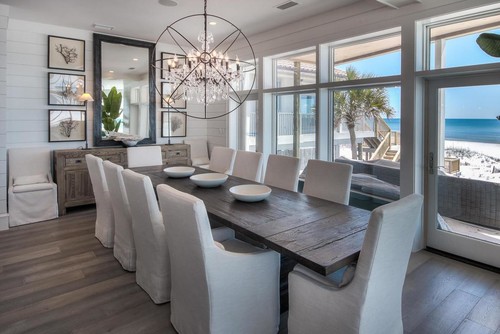
Traditional dining room lighting consists of a chandelier and matching sconces. The modern take on traditional features a streamlined chandelier, a linear fixture, or two or more matching chandeliers or pendants. Sconces are no longer a must-have; on the contrary, only choose sconces once the rest of the room is laid out and decided or you may end up with a different layout, culminating in off-center sconces, off-kilter drapery, or unsightly covers where the sconce holes were drilled.
Window treatments
Drapes are considered the most traditional option in the dining room, but they work in rooms of all sizes. Drapery doesn’t have to be expensive or custom-made; look for window treatments at stores like Home Goods, IKEA, or even Target and Wal-Mart. Just make sure to wash the drapes before hanging the rods and fabric; some materials may shrink. All drapery should be removable and cleanable.
Besides for the pattern and color of the drapes themselves, consider the rod, rings, and tie-backs. If you’re renting or on a budget, tension rods may work if your windows are deep-set; all rods are available in an array of finishes, from acrylic to brass to oil-rubbed bronze to aged silver and everything in between. Rings and tie-backs should coordinate with the general décor scheme; braided, tassled ties will look out of place in a sleek, modern room.
Though staged home-décor photos often show that you can mix and match patterns, it’s unadvisable unless you’re working with a skilled designer. Preferably, choose one feature of the room to pattern boldly. If you opt for busy wallpaper or moldings, pick plain chairs (and vice versa). Keep the flooring neutral to allow other elements to stand out; be sure wood tones in flooring and furniture don’t clash. Coordinate window treatments with other furnishings and fabrics; if the chairs are subtly patterned, a more dramatic drape is acceptable, but tone down the shades if you want the wallpaper to shine.
Sometimes the smallest touches make the biggest difference. Outfit your dining room with the right details to complete it.
- Textiles: tablecloth or runner, napkins
- Accessories: vases, flowers (fresh or faux), interesting centerpieces for the table or buffet
- Wall décor: mirrors (choose large and round over a sideboard for visual interest), art

